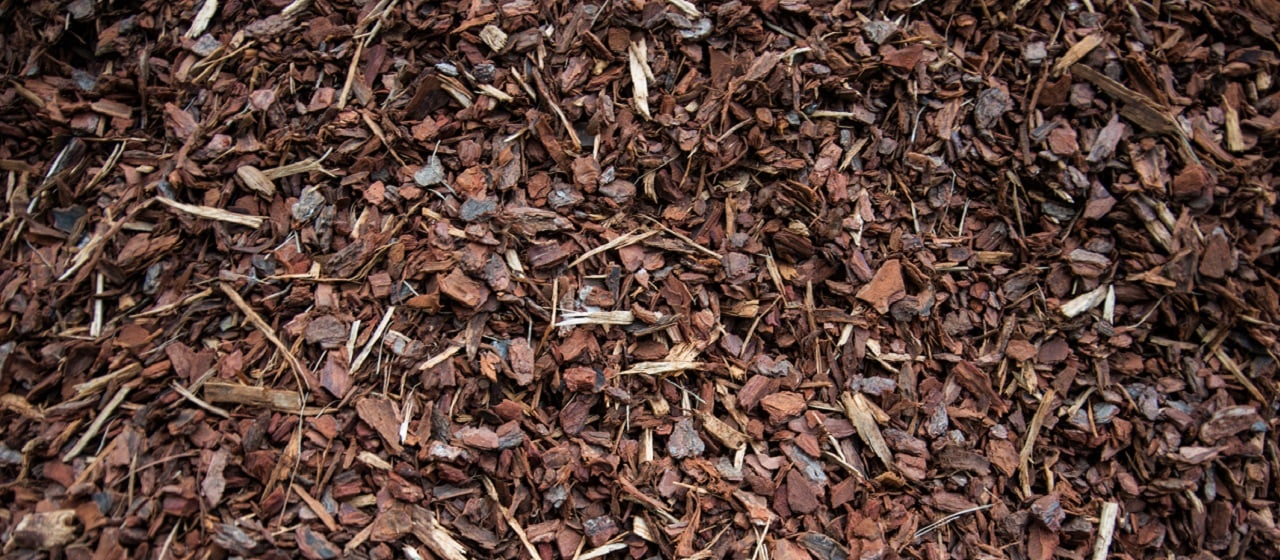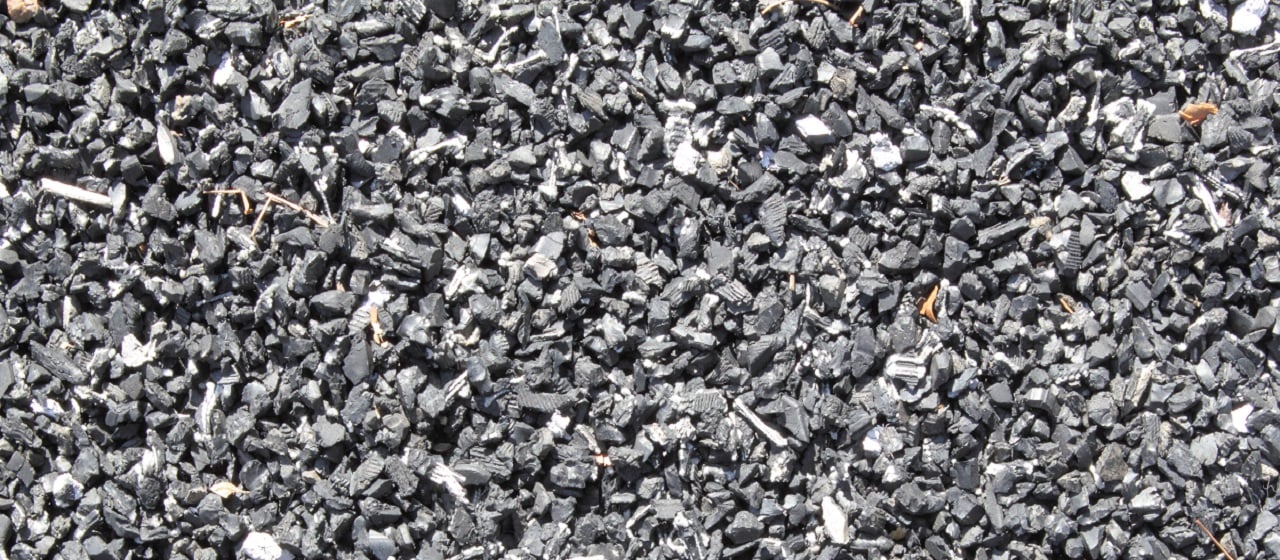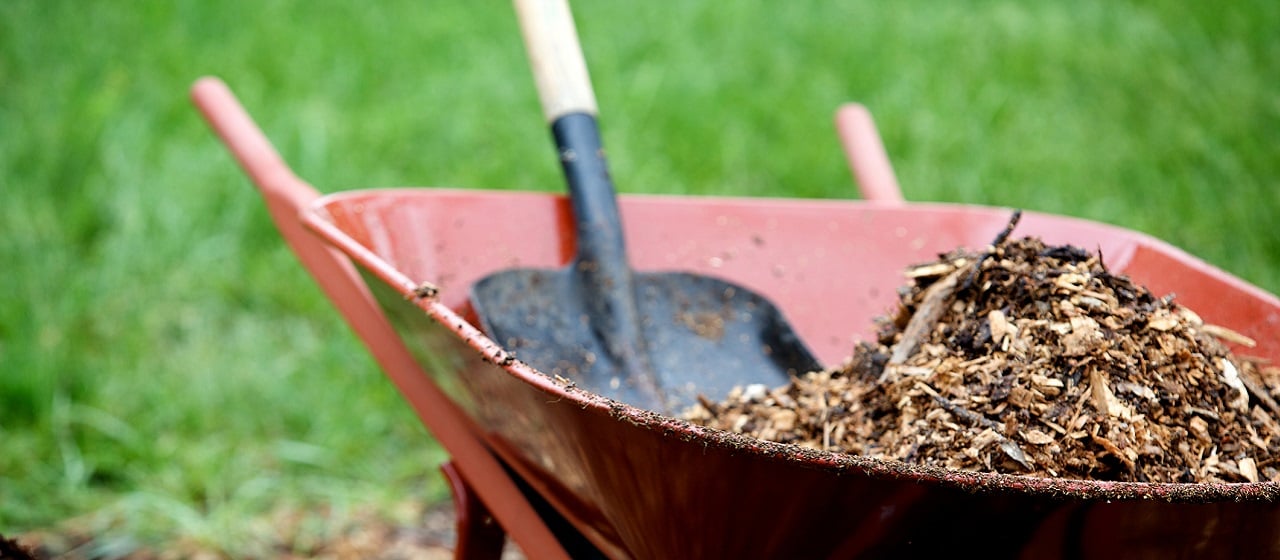

eyjafjallajokull/iStock / Getty Images Plus via Getty Images.
Simon McGill/Moment via Getty Images.
Wood and rubber mulches are both solid choices in the right circumstances. Rubber is popular for established ornamental gardens in stormy, cold to moderate climates because it’s heavier than wood and less likely to be blown or washed away. Wood mulch is better for edible gardens, as it doesn’t release dangerous compounds and metals, and is safer in hot climates, as it’s a lower fire risk than rubber. Use this guide to wood versus rubber mulch to find out which one is best for your yard.
On This Page
- What’s the Difference Between Rubber Mulch and Wood Mulch?
- Rubber Mulch vs. Wood Mulch: Which Is Better?
- Which is Best for Your Garden?
- Rubber Mulch vs. Wood Mulch: Which Is Best for Edible Gardens?
- Rubber Mulch vs. Wood Mulch: Which is Best for Play Areas?
- Rubber Mulch vs. Wood Mulch: Which Is Best for Areas of Elevated Fire Risk?
- Rubber Mulch vs. Wood Mulch: Which Is Best to Keep Ants and Termites at Bay?
- Rubber Mulch vs. Wood Mulch vs. Other Mulches
- Looks like wood chips
- High-end products don’t fade with age
- Available in bright and pastel colors
- Natural, organic appearance
- Doesn’t fade
- Limited natural color options
- Surface area requiring mulch
- Depth of mulch
- Guaranteed wire-free rubber mulch costs more
- Organic, untreated wood mulch costs more
- Wood species
- Rubber quality
- Installation costs an additional $20–$45 per cubic yard
- Mulch blowing costs $35–$60 per cubic yard
- Mulch delivery costs an extra $160–$270 for loads up to 15 cubic yards
- Less messy than wood mulch
- Won’t blow away while moving in windy conditions
- Heavier, so more challenging to move
- Requires a landscape fabric barrier
- More time-consuming to install
- Lighter than rubber mulch
- Does not require a landscape fabric barrier
- Messier than rubber mulch
- Not suitable for self-installing in windy conditions, as it’ll blow away
- Heavy, so it does not blow around. Therefore you won’t have to keep sweeping it back in place
- Does not need special care for mold or (most) fungi
- Does not need treatment for insect infestations (apart from Asian cockroaches)
- Lighter than rubber, so moves more easily, requiring you to sweep it back into place
- Can harbor mold, fungi, and insects, so it requires regular inspection and, if necessary, treatment
- Degrades faster than rubber, so it needs replenishing more often
- Diverts used tires from landfill
- Contaminates the soil locally with heavy metals and chemical residues
- Can kill plants by leaching large quantities of zinc into the soil
- Contaminants pollute groundwater
- Because of high levels of dangerous pollutants, it’s unsuitable for use with edible plants
- Natural, untreated wood is highly sustainable
- Diverts wood waste from landfill
- Renewable source
- Does not pollute the soil or water table
- Replenishes soil as it breaks down, providing fibers for good soil structure and nutrients for plant food
- If not ethically sourced, wood mulch is not a sustainable resource.
- Does not attract termites and carpenter ants
- Releases volatile organic compounds (VOCs) that can cause significant health problems, from minor dizziness and nausea to enduring liver, kidney and neurological problems
- You cannot grow fruit or vegetables where rubber mulch is, or has been used, because pollutants from the soil end up in the plants, so they are unsafe to eat
- Ignites easier than wood at lower temps, burns hotter and spreads faster, so it isn’t safe for areas of higher fire risk.
- Does not release VOCs
- If untreated, wood does not leach dangerous chemicals into the soil
- Does not negatively impact plant growth (unless you use walnut)
- Is less of a fire risk than rubber, as it’s harder to ignite and burns slower and at a lower temperature
- Safe to use when growing fruit and vegetables
- Can attract termites, ants and other pests
- May harbor mold spores that can cause irritation if inhaled
What’s the Difference Between Rubber Mulch and Wood Mulch?
Wood mulch is naturally occurring and, if sustainably sourced and untreated, is environmentally friendly. It also breaks down into fibers and nutrients to replenish the soil. Rubber mulch, on the other hand, has a longer lifespan and does not break down easily. It’s also heavier, so it resists weather and enthusiastic watering. Take a look at the differences between rubber mulch and wood mulch.
Rubber Mulch
Rubber mulch is made of processed, ground-up automobile tires and is most commonly used as a safety surface for children’s playgrounds. However, it is also gaining in popularity as a mulch. For garden purposes, rubber mulches usually look like wood mulch, but dyed variants are available for those who like a splash of color in their landscape.
Wood Mulch
Wood mulch is recycled wood matter, often bark, waste wood offcuts, old pallets, branches, and similar materials, cut into fine chips. The color and consistency differs depending on the species of wood used, the fineness of the cut, and the contents of the mulch. As wood is organic, it breaks down over time and nourishes and bulks out the soil. It’s equally popular as a safety surface for play areas and for garden beds and paths.
Rubber Mulch vs. Wood Mulch: Which Is Better?
Both rubber and wood mulch have many qualities that make them popular. Let’s take a look and find out which garden mulch is best for your home.
Appearance
Most natural looking: Wood mulch
These two popular mulches are tied pretty closely when it comes to appearance.
Rubber mulch:
Wood mulch:
Cost
Lowest cost: Wood mulch
Whether you have a few square feet to mulch or hundreds of cubic yards, cost is likely a leading factor in your decision-making process.
Factors that influence mulch cost:
Rubber mulch costs $80 to $160 per cubic yard, plus the extra costs listed above.
Wood mulch costs $30 to $110 per cubic yard, not including installation or delivery.

eyecrave/ E+ via Getty Images
Installation
Easiest to install: Wood mulch
Wood mulch and rubber mulch are both suitable for DIY installation if you have the skills, knowledge and tools. However, it’s labor-intensive and may not be practical in large areas. Plus, if you need more than a couple of small bags, you’ll need to hire a local mulch delivery service.
Instead, you’re probably better to hire a local mulching company to do the installation for you, as they’ll also take care of delivery and they have the right equipment to make the work fast and efficient.
Rubber Mulch
 Pros
Pros
 Cons
Cons
Wood mulch
 Pros
Pros
 Cons
Cons
Maintenance
Easiest to maintain: Rubber mulch
Ideally, garden mulch requires minimal maintenance and infrequent replenishment. But rubber and wood mulches have different needs when it comes to ongoing care and attention.
Rubber mulch:
Wood mulch:
Environmental Friendliness
Most environmentally friendly: Wood mulch
Environmental friendliness is a serious concern for many. But in the case of rubber versus wood mulch, the implications can vary.
Rubber mulch
 Pros
Pros
 Cons
Cons
Wood mulch
 Pros
Pros
 Cons
Cons
Health and Safety
Healthiest and safest option: Wood mulch
The health of your family and pets and their overall safety is a primary concern with anything you purchase, including the type of mulch you choose.
Rubber mulch
 Pros
Pros
 Cons
Cons
Wood mulch
 Pros
Pros
 Cons
Cons

annick vanderschelden photography / Moment via Getty Images
Which Is Best?
To help you decide which type of mulch is best for your property, you have to establish where and for what purpose you want to use it. Talking to a local landscaper if you’re still undecided is a smart move, as they can advise you.
Rubber Mulch vs. Wood Mulch: Which is Best for Edible Gardens?
Natural wood mulch is definitely the best option if you plan to grow fruits and veggies. Wood is safe and contains no VOCs, unlike rubber which can release gases that are dangerous to inhale. Plus, the chemicals and heavy metals that leach into the soil work their way into your plants, making them potentially unsafe to eat.
Wood also provides extra nutrients as it breaks down, along with fibrous organic matter that helps build healthy, well-structured soil to help maximize the health and production of your edible plants.
Rubber Mulch vs. Wood Mulch: Which is Best for Play Areas?
Rubber and wood mulch are tied on this one. Rubber is less messy and has a longer lifespan. Wood may not last as long and need regular replenishment, but it does not release any VOCs.
Both surfaces provide a softer, safer playing surface and offer some cushioning against falls and trips. Be aware that for safety, if you choose rubber, you need a guaranteed wire-free rubber mulch. This type of mulch will cost you more but ensures nobody gets stuck with or cut by painful, thin metal wires common in standard rubber mulch.
Rubber Mulch vs. Wood Mulch: Which is Best for Areas of Elevated Fire Risk?
Wood mulch is best in areas of moderate to high fire risk. Wood mulch requires higher temperatures to ignite, and it burns at a lower temperature than rubber and spreads slower. Wood has a lower carbon to nitrogen ratio than rubber and also holds moisture.
Rubber Mulch vs. Wood Mulch: Which Is Best to Keep Ants and Termites at Bay?
Rubber is better for keeping ants and termites away. Wood is a natural attractant for these pests, but rubber isn’t. However, do note that rubber mulch is the favorite place for female and nymph Asian cockroaches to hang out.
Rubber Mulch vs. Wood Mulch vs. Other Mulches
While wood and rubber are the most common types of organic and inorganic mulches, there are plenty of other alternatives. If neither wood nor rubber seems to be the right fit, take a look at these other types of mulch to see how they compare.
Vs. Straw
Straw is a budget-friendly mulch and costs around $22 per cubic yard. It’s effective and lets plenty of moisture pass through to reach your plants. But unlike rubber and wood mulches, you’ll have to replace straw every year.
On the other hand, straw is easy to move and apply yourself, and the remainder of the old mulch that you put into the topsoil helps to create good drainage and light, airy soil structure. Straw is great for protecting soft fruits from wet weather and insects and provides a good top layer if you’re preparing a bed for early spring growth.
Vs. Landscaping Fabric
Landscaping fabric is an inexpensive weed barrier that’s porous, so it still lets water and air pass through. It blocks weeds fairly effectively, but it’s not the most attractive option. Generally, it’s used as a weed barrier, then covered with a more decorative type of mulch. Landscaping fabric costs around $0.30 per square foot.
Vs. Pine Needles
Pine needles are comparatively expensive, costing an average of $150 per cubic yard. However, a little goes a long way, giving you a nice, deep mulch layer that aids water absorption and may provide a little more acidity. It’s a great choice for thirsty, acid-loving plants like magnolias, blueberries, bilberries, anemones and rhododendrons.
Vs. Yard Waste
Yard waste is free, but you need to be careful. Leaf litter, grass clippings, and general garden waste all make effective, free mulch. But they can more easily harbor pathogens and pests because this organic matter hasn’t undergone any significant frying or processing.
Vs. Rocks and Gravel
Rocks and gravel cost around $0.50 per pound, but they’re heavy, so costs can quickly add up. This type of mulch works well over landscaping fabric and is a popular option in areas where you don’t want lawns or garden beds. Gravel and rocks are effective at keeping weeds at bay, although some persistent ones may occasionally worm their way through.
Do note that the soil beneath the rocky area will be compacted and require significant conditioning if you ever decide to remove the rocks and use the soil.
Ready to start your mulch delivery? Pros
Pros Cons
Cons Raising Chickens at Home
Raising Chickens at Home  Composting and Landscaping at Home
Composting and Landscaping at Home  Home Gardening Tips: From Composting To Herb Gardens
Home Gardening Tips: From Composting To Herb Gardens  How to Pet-Proof Your Garden
How to Pet-Proof Your Garden  Tree Management, Removal and Safety
Tree Management, Removal and Safety 

Are You Familiar With This Topic? Share Your Experience.